In May 1959, Science News warned that there would be 25% warming of the earth by the year 2000 compared to 1850 (at the height of the first industrial revolution). Three years later, Rachel Carson published Silent Spring. This documented how biodiversity was being wiped out, with adverse environmental consequences by corporations and government’s connivance with them.
These events spurred the birth of the modern environmental justice movement. The voices of this movement became amplified when an oil well blow out on the coast of Santa Barbara, California killed more than 10,000 sea lions, dolphins, seals and other seabirds. A year later activists marked the anniversary of this catastrophe as the first Earth Day, with mass mobilisation that brought out 20 million Americans into demonstration across thousands of universities, colleges, secondary and primary schools.
Under the pressures of this movement, governments started showing concern for “environmental protection” in the 1970s, starting with the United States. It was however not until 1992 that the United Nations Conference on Environment and Development (UNCED) held in Rio de Janeiro, supposedly signalled international consensus to address the debilitating effects of humankind’s activities on the planet.
The Rio Earth Summit reached an agreement on the United Nations Framework Convention on Climate Change (UNFCCC). But despite several protocols and “agreements” based on this Framework, including the “Paris Agreement” in 2016, it is obvious that governments and big business cannot take the necessary steps to avert doom for all on earth and the earth itself.
The reason for this is not far-fetched. Climate change is mainly due to the activities of major companies, with just 90 multinational corporations from the highly industrialised countries being responsible for nearly two thirds of all gas emissions causing global warming. Governments serve the interests of the capitalists who own these companies. The despoliation of the earth is thus inbuilt into the for-profit logic of capitalist development, which drives accumulation for accumulation sake – all to expand capital and the stupendous wealth of “the 1%”.
Working-class people and youth are now taking our fate in our hands. We are going beyond talking to the governments of the bosses or organising demonstrations simply as “policy advocacy campaigns” during conferences of the parties (COPs) to the UNFCCC. Rebellion is the way forward to a revolutionary overthrow of the capitalist system which thrives on merciless exploitation of both the earth and our labour.
Youth strike for climate – young people show the way!

The most celebrated of these instances of rebellion is the “school strike for climate”. Initiated last August by 15-year old Greta Thunberg, a high school pupil in Sweden, it became a global movement in just a matter of months. On 15 March, the spark of rebellion she lit became a bonfire, with 1.4 million young people boycotting school to demonstrate against the unserious response of world leaders to climate change in 123 countries.
Greta was shocked by the dangers posed to the future generation by climate change and the lack lustre interest for action to stop these by those in power, for several years. She became inspired by how tens of thousands of students in the United States walked out of school to protest the United States gun laws after 17 were killed in a high school shooting at Florida, last year March and decided to ignite a similar act of rebellion.
This shows how struggle on an important social issue could inspire and provide lessons on tactics for struggle on other issues, underlining the interconnectedness of our fight for a better world. But when she started to take action on 20 August 2018 (boycotting school to stand in front of the Swedish parliament with a placard and leaflets which she distributed to passers-by) she was alone but remained undeterred.
This is also a lesson for all change-seeking activists. Even when we are few, or stand alone in struggle for a better world, we must not be discouraged. Rather, we should stand firm and work out how to mobilise more people into our folds for collective struggle.
Momentum was gathered as more and more young people were won to the need for rebellion to demand action. Every Friday became a climate strike day in several countries. School students that had never met before utilised social media to establish inclusive grassroots networks across cities and towns that coordinated their rebellion.
Specific demands against local and national policies and (in)actions of governments and big business which promote global warming were made. Their perspective was captured by the students in Australia who said: “we are temporarily sacrificing our educations to save our futures from dangerous climate change”.
Some “fossil fuel lobbyists, politicians and journalists” have come out to attack Greta Thunberg and the movement she is leading, and some greenwashing entrepreneurs like Ingmar Rentzhog have leveraged on the movement’s goodwill to make money. They are however the less dangerous enemies. Greta’s response to them was “I expected when I started that if this is going to become big, then there will be a lot of hate”. And she added “It’s a positive sign. I think that must be because they see us as a threat. That means that something has changed in the debate, and we are making a difference.”
The politicians who have put profit over the people and planet earth have played to the gallery, feting Greta and praising her boldness. These include party leaders in Britain, Emmanuel Macron in France and Angela Merkel in Germany.
These young rebels are however not fooled at all. Greta’s take on their “support” is simple and straightforward: “They are still not doing anything. So, I don’t know really why they are supporting us because we are criticising them. It’s kind of weird.”
Much more significant and sincere has been the support of academics (224 of which signed a statement in support of the movement) and older generations of activists.
The young rebels “have watched as politicians fumble, playing a political game rather than facing the facts that the solutions we need cannot be found within the current system.” And they realise that “we need to change the system if we are to try to act on the climate crisis”
Rebellion against extinction – striking to save the planet?
The flag of rebellion to save the planet is being raised by a broadening circle of activists. Grassroots movements and networks in rebellious campaigns for concrete action on climate change, include; the Sunrise Movement which supports the Green New Deal of Rep. Alexandria Ocasio-Cortez and Sen. Ed Mackey in the United States; Extinction Rebellion an “international movement” which won the Labour party endorsement of its call for radical change to save humankind’s extinction and ecological collapse, after a week of protest that shut down central London in the third week of April, and; Earth Strike, a “people’s movement” targeting “the institutions of production”, with a schedule of events throughout the year, expected to culminate in a “global general strike” on 27 September.
While these movements share a spirit of rebellion in struggle to avert climatic and ecological catastrophe, they are different in orientation and strategy. Sunrise movement (which was incorporated in 2017 and has inspired action in a few other countries) appears to be “building an army of young people to make climate change an urgent priority across America”. They are not “looking to the right or left”. They rather “look forward” as they put it. This includes looking forward to change through parliamentary legislation which they hope to influence with mass action.
Extinction Rebellion (XR), was formed last May in Britain and now has groups in about a dozen countries (mainly in Europe). Inspired by a long history of non-violent civil disobedience – from the Chartists, Suffragists (who fought for the right of women to vote), the civil rights movement in America and Occupy – its supporters have organised a series of “rebellion days”, drawing thousands of protesters since the November. XR has also issued calls to action, and open letters signed by a hundred academics from its ranks.
 Its core demands are for government to: tell the truth about the climate and ecological emergency; enact legally binding policy measures to reduce carbon emission to net zero by 2025; and constitute a national citizens’ assembly to oversee changes meant to avoid extinction. While arguably a more radical programme than that of Sunrise Movement and drawing in thousands which include radicalised workers and youth, XR’s goal is no less reformist. It has faith in the subsisting system and its governments to pull off the slippery road to perdition.
Its core demands are for government to: tell the truth about the climate and ecological emergency; enact legally binding policy measures to reduce carbon emission to net zero by 2025; and constitute a national citizens’ assembly to oversee changes meant to avoid extinction. While arguably a more radical programme than that of Sunrise Movement and drawing in thousands which include radicalised workers and youth, XR’s goal is no less reformist. It has faith in the subsisting system and its governments to pull off the slippery road to perdition.
Earth Strike appears to have a more radical agenda, with a clarity of message that the site of the problem is the commodity production process. Formed in November through discussion on an online platform, its proponents realise that voting is not enough to redress the situation – there is a need to disrupt the system, if there will be real change. It has thus called for a mass general strike on 27 September, on the anniversary of Rachel Carson’s Silent Spring. In typical horizontalist traditions, it is a loose network of grassroots activists.
Placing a general strike at the centre of its strategy, shows a recognition of working-class power to change the world, including ending the slide towards calamity, which capitalism is pushing humankind towards. But, recognising the power of the working-class is not enough. Working-class power can be wielded only by the working-class itself. You cannot shave someone’s head in her/his absence.
Earth Strike’s mobilisation for a global general strike being done outside the working-class movement puts paid to 27 September being more than mere grandstanding. That much can be seen from the kick-off of its series of #EarthStrike protests for the year in January. Despite its lofty announcement that “We, the people of the world, are Demonstrating on the 15th of January 2019 to save the Planet”, merely drops in the ocean of billions of working-people across the world were even aware of any demonstration in their name.
It is not accidental that these diverse trends of rebellion to save the earth emerged in the last two years. It became clear that climate change is even worse than we think, six years ago. As if that were not terrible enough, the Special Report on global warming issued by the International Panel on Climate Change shows that world leaders were way off the mark with the limit of 2% increase in global warming set in the Paris Agreement. The dangers of going above 1.5% are existential. And if care is not taken, that existential limit will be overshot between 11 and 20 years.
“Rapid and far-reaching” transitions in social organisation is of the essence to avoid plunging the earth into the cauldron of extinction. Such transition cannot be achieved within the framework of capitalist development. “We need to change the system” as 16-year old Greta Thunberg noted.
What can we do?
The disaster associated with climate change is not something faraway in the future or something confronting only people in distant climes. We can see it in the floods that have become regular incidents, claiming hundreds of lives and destroying homes and farms across Nigeria over the last seven years. It is at the root of the killing heat that now characterises the dry season. Cyclone Idiai swept through Mozambique, Malawi and Zimbabwe leaving 1,000 people dead – this is the face of climate change in Africa.
This disastrous reality is set to get worse in Nigeria as in other places across the world. As the recently released 2019 Annual Flood Outlook (AFO) of the Nigeria Hydrological Services Agency shows, 36 out of the 37 states of the federation including the Federal Capital Territory are likely to be flooded during the forthcoming rainy season. This could make the 2012 floods which claimed 363 lives and left not less than 2.1 million people displaced seem like child’s play.
There is thus a pressing need for more activists and the labour movement to be much more involved in spreading rebellion for system change to avert further climate change.
It is worrisome for example that not a single demonstration has been organised in Nigeria (and only one across the continent i.e. of 2,000 people in Cape Town) as part of the School Climate Strike movement. The trade union movement is also yet to wake up to the critical importance of the need for climate action. A few resolutions have been passed at Conferences on climate change and environmental justice. But next to no practical steps have been taken based on these.
Students in high schools and tertiary institutions across the country should be organised to come out in protest on Fridays. Unions and movements in the education sector (NUT, NASU, ASUP, COEASU, ASUU, TIB, ANSA, NANS etc) and the trade union centres must mobilise for this. We must march in rebellion with environmental justice organisations such as the Environmental Rights Action (ERA/FoE) and Home of Mother Earth Foundation (HOMEF) across our communities.
NLC and TUC also have a lot of work to do. The trade unions and rank and file workers need to be mobilised for mass demonstrations, like those that have been organised to protest against corruption, for example. Trade unions and workers in Nigeria should get involved in progressive and radical global networks and campaigns within the international trade union movement which they could draw lessons and inspiration from, such as the Trade Unions for Energy Democracy (TUED) and One Million Climate Jobs Campaign.
Climate change is a global problem, engendered by the international capitalist system. Worldwide rebellion of the working-class is essential to defeat the for-profit interest of capitalists, which is at the heart of global warming. Simply “positioning the labour movement in the climate agenda” is definitely not enough, at this point in time. It is crystal clear that “ending climate change requires the end of capitalism”. The trade unions must have a stomach for this!
As working-class and youth activists, in our unions, social movements and communities, our battle-cry of rebellion to save the earth must ring out loud and clear – System Change and not Climate Change!
by Baba AYE
- An abridged version of this article was published in the newspaper version of Socialist Worker, May-June 2019









